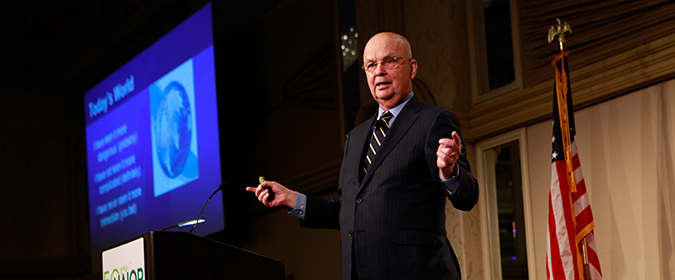“I’ve seen the world more dangerous, but I’ve never seen it more complicated.”
This is how General Michael Hayden began his analysis of the tumultuous global environment at the Chapter Leadership and Legislative Retreat this week in Washington, D.C. Nearly 300 chapter leaders from across NAIOP’s North American network gathered to hear from the retired four-star general, who served as director of the Central Intelligence Agency and the National Security Agency during the war on terror and the growing cyber challenge.
Hayden began by talking about the new age of globalization. In the industrial era, it was about accumulation of power at the center: only a centralized government could “make things happen” and protect its citizens and allies. Now, in the post-industrial information age, power doesn’t trend to the center, but seems to more naturally flow out to individuals.
“I remember when I had to talk to a human to get my money out of the bank,” Hayden commented. Americans used to visit major institutions or hire certified professionals to meet our needs. Today, realtors have been replaced with Zillow, our bank tellers traded for ATMs, and a private company (Google Earth) instead of a government agency can provide us with satellite images of much of the world.
This trend means sub-state actors and individuals are empowered for better or for worse, as Hayden pointed out. Small groups of radical terrorists and hackers can pose major threats to developed countries.
Along with this new trend in power flow is what he sees as “a widespread melting-down of the post-WWII liberal world order.” Institutions such as the United Nations and rule-based relations will no longer be the norm. A secular nation-state is no longer a building block of the international stage. “That is the case for the next generation – not just the next headline,” he added.
Then there is the threat of nuclear proliferation. Before the end of Trump’s administration, Hayden said, North Korea will have the technology to reach the Pacific Northwest with a nuclear missile. Russia is re-arming their nuclear force and investing in nuclear modernization, and Pakistan is manufacturing the weapons at an alarming rate.
So how is President Trump poised to cope with this new world order?
“The historian Walter Russell Mead places Trump within a ‘Jacksonian’ tradition of American foreign policy: nationalist, populist, suspicious of the outside world – and willing to use force to beat it back,” according to the New York Times, cited by Hayden. Trump professes dedication to the land and the people and less to the structures that supported it over the last century.
Hayden identified the following tenants of “Trump Doctrine:”
- Immigration will be seen more as a threat than a strategic advantage.
- Foreign engagements will be reluctant, limited and short.
- Free trade will be challenged as a principle of American prosperity.
- Alliances will be seen more as transactional than strategic relationships.
- Expect a peer and near-peer reshuffle – China down, Russia up?
- The fight against terror will be fundamentally about more combat power.
Ironically, Hayden pointed out that many of Trump’s nominees (which he called “first-round draft picks”) disagree with these views. “[United States Secretary of Defense Jim] Mattis got picked because Trump thinks he’s [General George] Patton. He’s not – he’s [General George] Marshall.”
According to Hayden, these military heavyweights generally consider the United States’ biggest threats to be, in descending order:
- Russia
- China
- Jihadism
- The southern border with Mexico
“But for Trump, that order is reversed,” Hayden pointed out.
Back in the early 15th to 17th centuries, the age of European discovery facilitated major economic growth, achievements in science and technology, and explosions in commerce, but it also brought about global epidemics, piracy and the slave trade. Hayden sees trade-offs in this new era as well.
His closing: “Buckle up. It’s going to be a tough century.”














